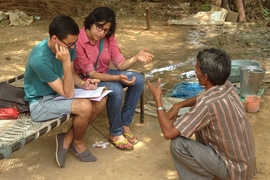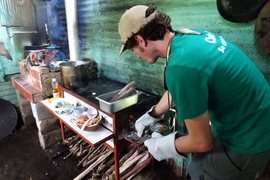For D-Lab’s Eric Verploegen Phd '08, statistics are more than, well, statistics — especially when they concern the quality of life for people living in poverty. So when he read about the more than 1 billion people in the world living without reliable access to electricity, he wanted to do something about it.
He got his chance when he joined D-Lab’s Scale-Ups program in early 2014 and started the Off-Grid Energy Group, which conducts work in the areas of needs assessment, technology evaluation, and market deployment.
“Over time, a solar lantern can save a household money while providing safe, higher-quality, long-lasting light,” Verploegen explains. “While solar lanterns are available throughout the developing world,” he continues, “selecting the right solar lantern is critical where the investment may equal as much as a third of a family’s monthly income.”
It’s an investment that many in the developing world are willing to make. A reliable solar lantern can be life-changing where people otherwise rely on expensive and toxic kerosene lamps — or forgo the luxury of light after sundown. Solar lanterns enable children to study into the evening, make household chores easier at the end of the day, reduce the risks of moving around outside after dark to tend to animals or go to the toilet, enhance social time with friends and family, and many models enable families to charge cell phones.
However, with hundreds of solar lighting products on the market in the developing world, it’s not easy to compare the cost and quality of multiple products in order to make the best possible purchasing decision.
Now, with the help of a new online resource, Solar Lighting Product Comparison from the D-Lab Off-Grid Energy Group, consumers and distributors can compare more than 55 products ranging from solar lanterns used for basic lighting needs to solar power and lighting systems with the capability to power appliances such as mobile phones, radios, fans, and TVs, in addition to providing lighting.
“There are many organizations and programs working to increase access to solar energy products where they are most needed,” Verploegen says. “Our job was to figure out what was missing.”
Verploegen was intrigued by the work coming out of MIT’s Comprehensive Initiative on Technology Evaluation (CITE). CITE has developed and piloted a methodology for evaluating products intended for the developing world focusing on the dimensions of suitability, scalability, and sustainability. Their first study of solar lanterns available in Uganda, published in early 2015, included a comparative chart of solar lanterns available in Uganda. “CITE is pioneering a rigorous methodology for evaluation,” comments Verploegen. “What D-Lab’s Off-Grid Energy wanted to bring to the table was the rapid dissemination of comparable product specifications linked to geographically organized distributor contact information around the world.”
Verploegen didn’t have to start from scratch. Inspired by CITE’s Uganda Solar Lantern study, Verploegen researched the availability of solar lighting product information that was global in scale. He found Lighting Global, the World Bank Group platform, which has been providing basic information on solar lighting products that meet minimum quality standards since 2009 and continuously updates their database.
In developing this resource, D-Lab’s Off-Grid Energy Group working from Lighting Global’s database (in fact, they will include only products that have passed Lighting Global’s quality assurance standards) and takes it a step further. Working with Eric Ferraiuolo, a volunteer software engineer, and Chitti Desai, an undergraduate intern from Wellesley College, Verploegen built a database that combines technical specifications of high-quality solar lighting products and information on distributors that sell products in various countries throughout the developing world.
“The system provides country-specific information sheets with key technical specifications of solar lighting products in a table format that makes comparison easy, and contact information for distributors that sell the products locally,” Verploegen says. The database includes information on more than 100 distributors operating in 47 countries across Africa, Latin America, Asia and Oceana, allowing consumers to determine which products are available and where they can purchase them.
Additionally, a full product comparison table is set up in a straightforward, sortable Google sheet that provides detailed information on model, manufacturer, price (in U.S. dollars), lighting output, settings and runtime, battery and solar panel specifications, features and accessories, as well as information on the warranty and certifications for some 50 products.
“It is exciting to see our colleagues at D-Lab building upon CITE’s approach to develop and release such an important resource for people living in poverty,” comments Joanne Mathias, associate director of CITE. “Access to information such as this is invaluable if technology is to truly improve lives and livelihoods in the developing world.”
Verploegen has a South Sudanese friend now living in the Boston-area who will be visiting his home country soon. "Phillip knows I’ve been studying solar lanterns," Verploegen says, "and he asked me how to advise friends and family on which solar lanterns to buy. Now I can point him to this resource. His friends can click on South Sudan and find a review of products and distributors as well as detailed technical specifications in the full comparative chart.” He continues, “If the product they want is not available in South Sudan, they can use the database to look at for products available in neighboring countries such as Uganda, Kenya, and Ethiopia, and even set up businesses to import the products to their communities.”
“Our goal is getting the right product into the hands of the people who need solar lighting the most and increasing the odds that investments made in these products serve the purchasers well,” Verploegen says. “We not only want to increase access to energy for some of the people that make up that one billion currently without, we want to help increase the odds that they’ll get access to the right products for them.”
The Solar Lighting Product Comparison from the D-Lab Scale-Ups Off-Grid Energy Group is part of a larger effort to develop tools and resources for increasing energy access for off-grid communities in the developing world. In addition to the Solar Lighting Product Comparison project, the group is developing resources for needs and market assessments, as well as a selection of distribution strategies for energy products.













